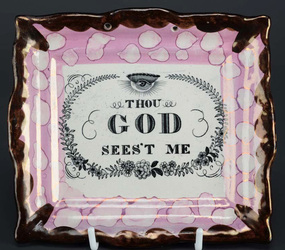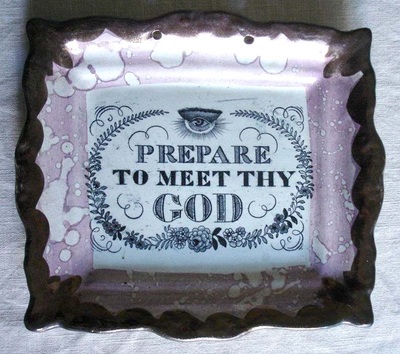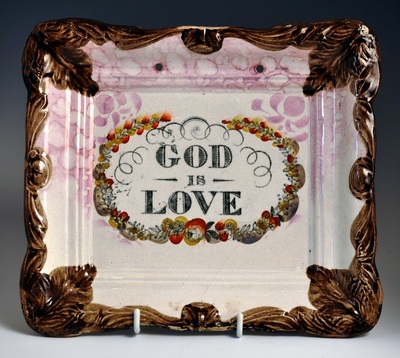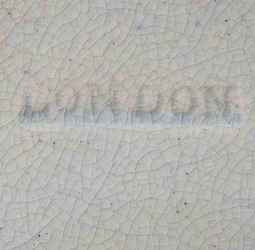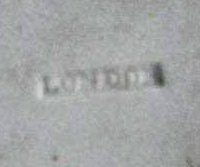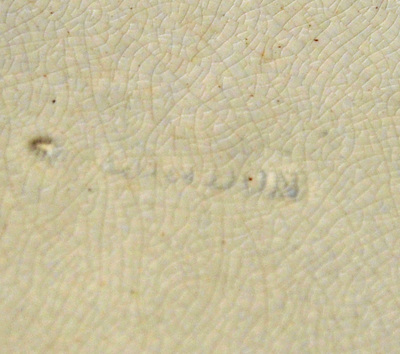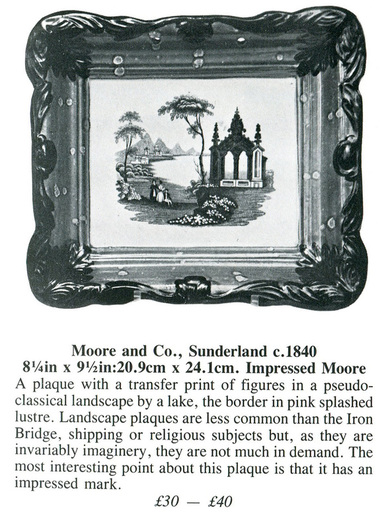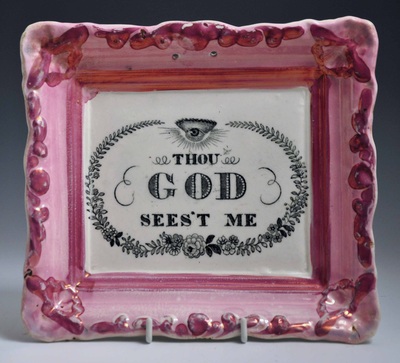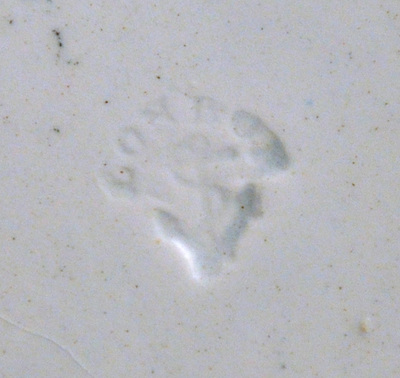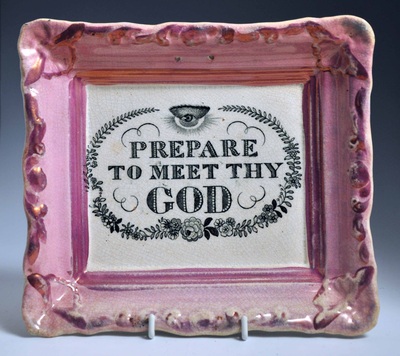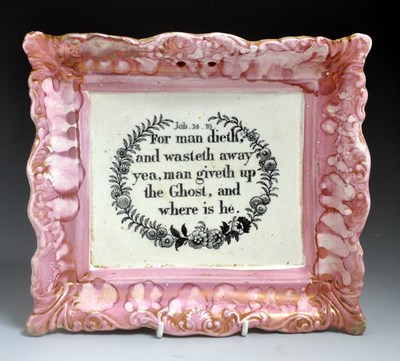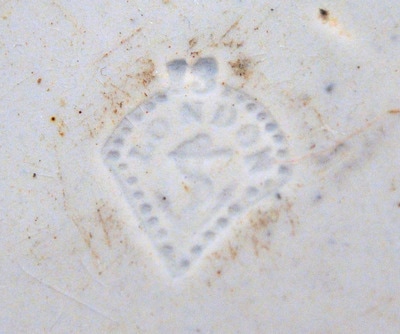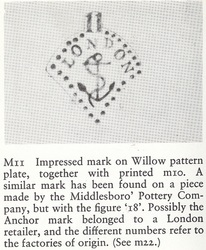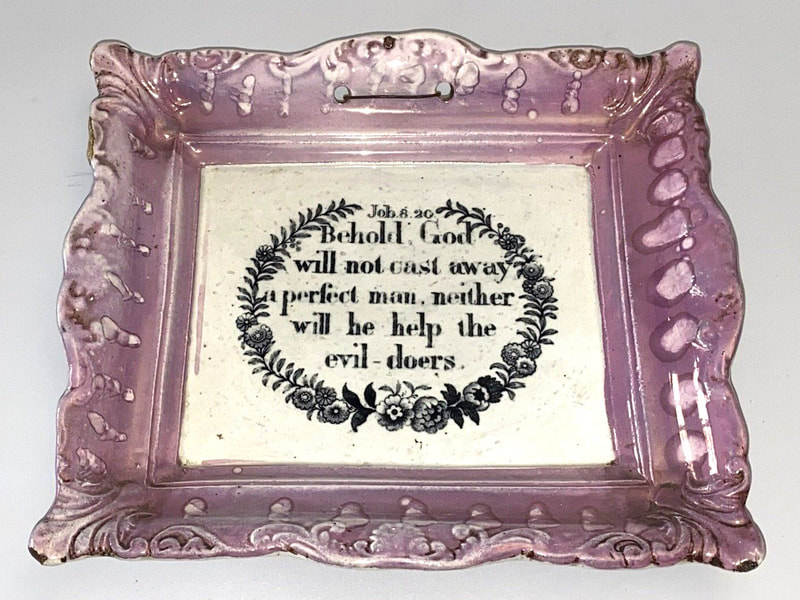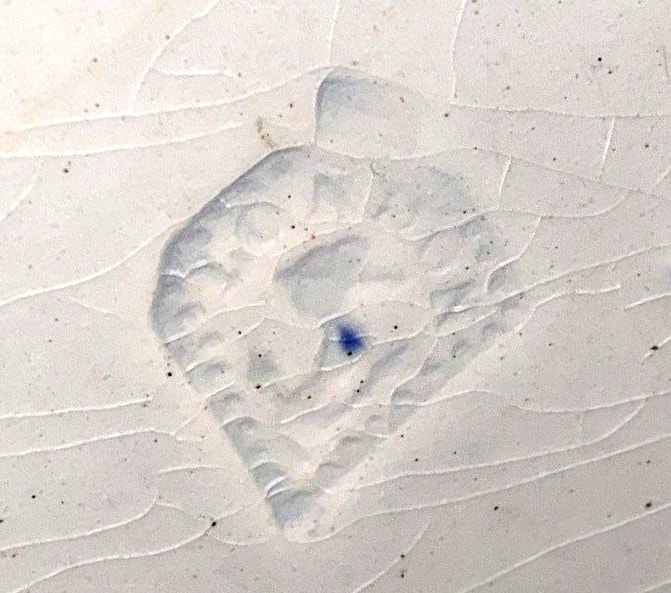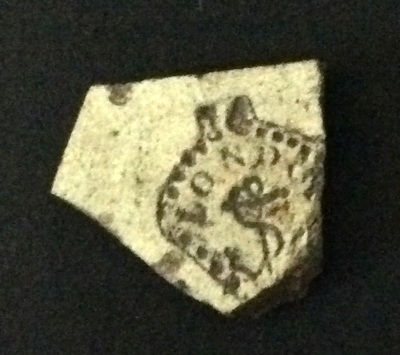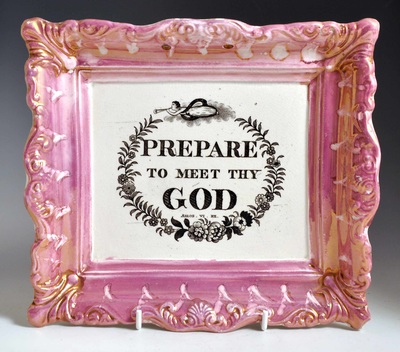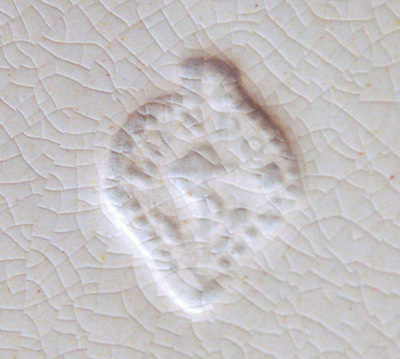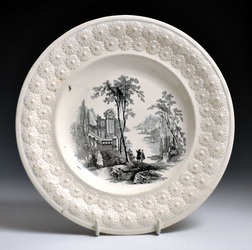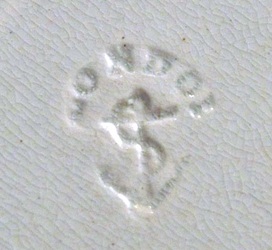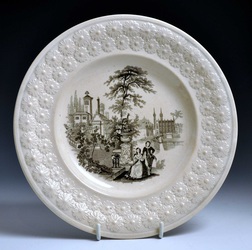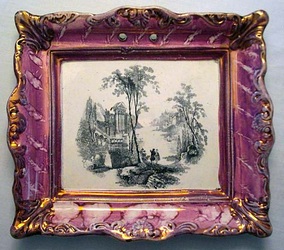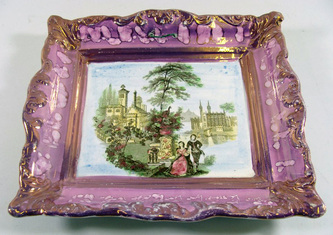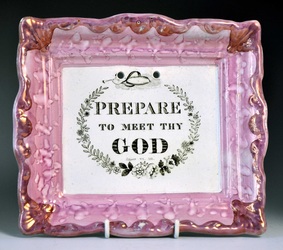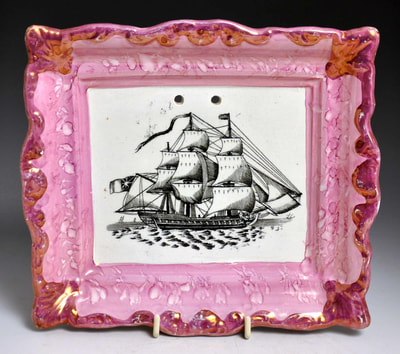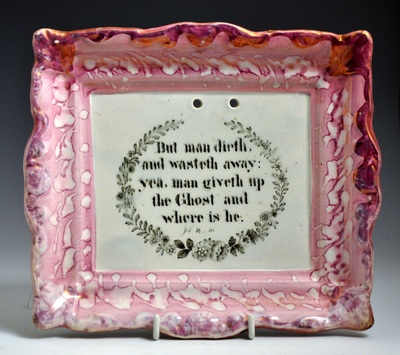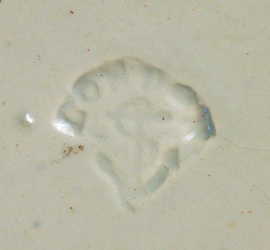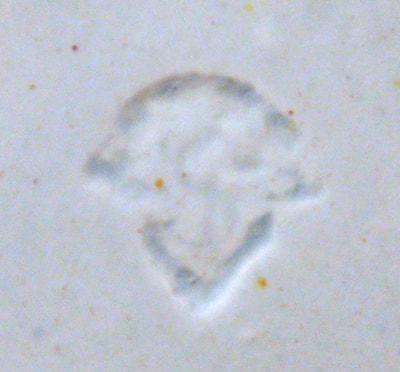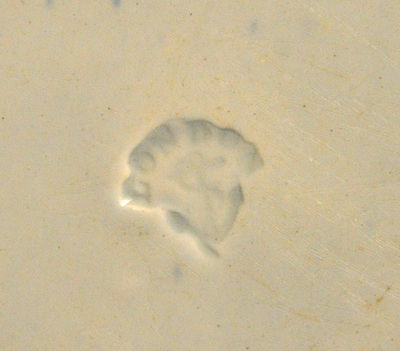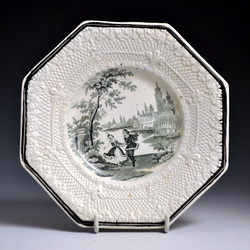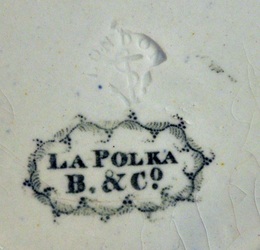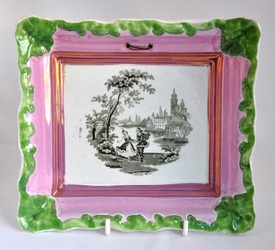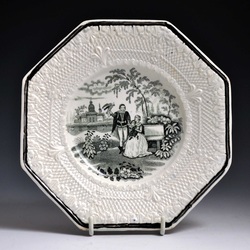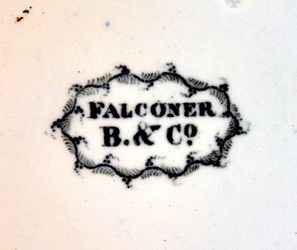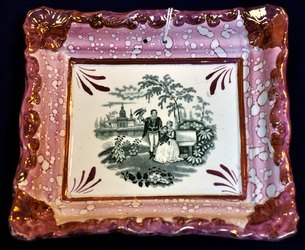'LONDON' impressed mark
North Eastern pottery sometimes appears with an impressed 'LONDON' mark, either as the word on its own or above an impressed anchor. Sometimes marks with anchors are surmounted by an impressed number. The marks appear on all sorts of transfer printed wares, e.g. blue and white willow pattern, brown and white printed tea services. For two lustre bowls with London impressed marks, see the United Collections website.
This page is concerned with the London marks as they appear on plaques or related items.
The London mark was most likely used to identify items destined for a London wholesaler/distributor. It sometimes appears in conjunction with printed marks from North Eastern potteries, e.g. Isaac & Thomas Bell and John Carr & Co, so it doesn't seem likely that its purpose was to conceal the origin of the wares.
Clarice Blakey in the Northern Ceramics Newsletter (83, p50–51) suggests five reported users of the LONDON mark:
Middlesbrough Pottery, 1834–52
Isaac and Thomas Bell, Albion Pottery, 1860–63
John Carr & Co and John Carr & Sons, Low Lights Pottery North Shields, 1846–1893*
Malkin, Walker and Hulse, British Anchor Pottery, Longton, 1858–64
Fell & Co, St Peter's Pottery, Newcastle on Tyne, 1817–1890
*See the North Shields Pottery partnerships page
To those we can probably add another pottery:
Burn & Co, Stepney Bank Pottery, Ouseburn, 1852–1860
Jack Cockerill (Northern Ceramics Newsletter 110, p36) suggests that Isaac Bell acted as an agent between these manufacturers and a wholesaler/retailer, presumably in London. Clarice Blakey writes 'The pottery of Thomas Fell and Co was established 1817. The original partners were Thomas Bell and Thomas Fell. There may have been a family connection between Thomas Bell [...] and Isaac and Thomas Bell, who potted at the Albion Pottery on Tyneside from about 1860. There may also be a connection with Isaac Bell, who was agent for the Middlesbrough Pottery, but left to run a pottery in Newcastle.' Jack Cockerill notes that an Isaac Bell ran the Phoenix Pottery in the early 1840s. John Carr and John Patton took over the running of that pottery in 1846 (see the North Shields Pottery partnerships page). So another potential link.
The Stepney Bank Pottery was run by Thomas Bell & Co, 1847-52, before ownership transferred to Burn & Co. Bell is, however, a common surname in the north east, so more work needs to be done to establish the connections between the above potteries.
Thanks to Anderson and Garland, Gary Spence, Philip Rutherford, Boulton & Cooper, and York Museums for contributing photos to this page.
This page is concerned with the London marks as they appear on plaques or related items.
The London mark was most likely used to identify items destined for a London wholesaler/distributor. It sometimes appears in conjunction with printed marks from North Eastern potteries, e.g. Isaac & Thomas Bell and John Carr & Co, so it doesn't seem likely that its purpose was to conceal the origin of the wares.
Clarice Blakey in the Northern Ceramics Newsletter (83, p50–51) suggests five reported users of the LONDON mark:
Middlesbrough Pottery, 1834–52
Isaac and Thomas Bell, Albion Pottery, 1860–63
John Carr & Co and John Carr & Sons, Low Lights Pottery North Shields, 1846–1893*
Malkin, Walker and Hulse, British Anchor Pottery, Longton, 1858–64
Fell & Co, St Peter's Pottery, Newcastle on Tyne, 1817–1890
*See the North Shields Pottery partnerships page
To those we can probably add another pottery:
Burn & Co, Stepney Bank Pottery, Ouseburn, 1852–1860
Jack Cockerill (Northern Ceramics Newsletter 110, p36) suggests that Isaac Bell acted as an agent between these manufacturers and a wholesaler/retailer, presumably in London. Clarice Blakey writes 'The pottery of Thomas Fell and Co was established 1817. The original partners were Thomas Bell and Thomas Fell. There may have been a family connection between Thomas Bell [...] and Isaac and Thomas Bell, who potted at the Albion Pottery on Tyneside from about 1860. There may also be a connection with Isaac Bell, who was agent for the Middlesbrough Pottery, but left to run a pottery in Newcastle.' Jack Cockerill notes that an Isaac Bell ran the Phoenix Pottery in the early 1840s. John Carr and John Patton took over the running of that pottery in 1846 (see the North Shields Pottery partnerships page). So another potential link.
The Stepney Bank Pottery was run by Thomas Bell & Co, 1847-52, before ownership transferred to Burn & Co. Bell is, however, a common surname in the north east, so more work needs to be done to establish the connections between the above potteries.
Thanks to Anderson and Garland, Gary Spence, Philip Rutherford, Boulton & Cooper, and York Museums for contributing photos to this page.
John Carr-attributed plaques
London marks most often appear on plaques attributed to John Carr (see the three plaques below). The mark is much rarer on plaques than the photos on this page might suggest. These are the only London-marked examples I know of, whereas I've seen hundreds of similar unmarked plaques.
The description below, from Battie and Turner's 'The Price Guide to 19th and 20th Century British Pottery' (reprinted 1990 by the Antique Collectors' Club), confused me at first. However, I am now certain that the impressed mark on this plaque reads 'LONDON' and not 'MOORE'. The plaque is again attributed to John Carr.
The London mark, above an anchor, appears on earlier plaques attributed to Carr with similar verse transfers. Both of the plaques below are marked.
John Carr & Sons (not Middlesbrough Pottery)
The first plaque has a 'London' impressed mark with an anchor and number, perhaps '13' or '18'. R C Bell, in his book 'Tyneside Pottery' (see below right), attributes London marks with number 18 to Middlesbrough Pottery (1834–1844). However, the plaque is of a form, and has a quality of lustre, associated with John Carr (see the For/But man dieth... page for a marked Carr example). The Dorman Museum in Middlesbrough has no record of Middlesbrough ever producing lustreware. The number on the second plaque is indistinct. The third plaque below has a number '12'. Similar plaques with this transfer have also been recorded with the John Carr and Sons impressed mark.
The image of the shard above, supplied by Ian Sharp, was found at the site of Carr's Low Lights Pottery. Ian writes: attached is the image of the unglazed pottery shard. It is finely potted, approx. 2.5mm thick. It clearly shows the number 14 above. This was found with a load of other unglazed pottery spoil near to the Low Lights Pottery site. It is documented that John Carr used a lot of the spoiled kiln waste, damaged pottery from the pottery to be used as infill in and around the area for roads and the like. This piece was found just a hundred yards or so, slightly up the bank on waste ground next to the Pottery.
Landscapes that appear on John Carr & Co plates
The below plaques are both unmarked. Transfers, apparently from the same copper plates, appear on daisy-bordered plates with the London impressed mark above an anchor (see top left and right below). A variation of the transfer appears on daisy-bordered plates marked J CARR & Co. Read more here.
Fell & Co, St Peter's Pottery, Newcastle
The three plaques below have the London impressed mark over an anchor shown beneath them. Similar plaques appear with the crown impressed mark used by Thomas Fell. The position of the hanging holes is also a feature associated with Fell.
J Burn & Co, Stepney Bridge Pottery
On the left below are two children's plates with printed marks on the reverse 'La Polka' and 'Falconer'. The first has a London impressed mark. The transfers and printed marks also appear on plaques (right below). However, as yet, no plaque with these transfers has been recorded with the London impressed mark. Ian Sharp, who has many years' experience cataloguing North Eastern pottery, has identified the printed mark as the Tyneside company J Burn & Co from the Stepney Bank Pottery, Ouseburn, 1852–1860. Interestingly, that isn't one of the potteries on Clarice Blakey's list of users of the London mark.
R C Bell (Tyneside Pottery, 1971) shows a Burn & Co printed mark, very similar to that used by Thomas Fell. It has two sea horses around a shield underneath which is written 'B.&Co.'
R C Bell (Tyneside Pottery, 1971) shows a Burn & Co printed mark, very similar to that used by Thomas Fell. It has two sea horses around a shield underneath which is written 'B.&Co.'
